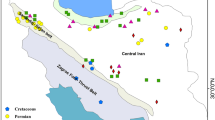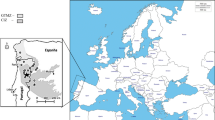Abstract
The present work assesses the potential industrial uses of Paleocene limestone deposits, Garra Formation in Sinn El-Kaddab Plateau, South Western Desert of Egypt, based on their mineralogy and geochemical characteristics. Eighty-six limestone samples collected from ten stratigraphic columnar sections were analyzed using X-ray diffraction (XRD) and X-ray fluorescence (XRF) techniques. Petrographically, Garra limestone deposits consist dominantly of benthic foraminiferal wackestone and packstone microfacies. The XRD data revealed dominance of low-Mg calcite as essential carbonate mineral in the studied limestone. The bulk rock XRF results revealed CaO (29.28–55.75%) with an average of 52.74%. The CaO exhibits a strong negative correlation with MgO, SiO2, TiO2, Al2O3, and moderate negative correlation with Fe2O3 which indicates that the contribution of these elements is mainly due to detrital input. On the other hand, Al2O3 and Na2O contents exhibit significant negative correlation with loss of ignition (LOI) wt% indicating their incorporation within terrigenous matrix. The average Sr content attains 1297 ppm indicating deposition in temperate marine environment. The average molar CaCO3% values of bulk samples have been computed for individual columnar sections to determine the purity status of Garra limestone deposits. They range from impure (CaCO3% = 79.92%) to high-pure (CaCO3% = 97.76%) limestone. Therefore, Garra limestone deposits have extremely valuable uses in a wide spectrum of industrial applications including Portland cement, steel, ceramics, whiting, chemical uses, paper, and feed stuff.






Similar content being viewed by others
References
Abou Elmagd K, Ali-Bik MW, Abayazeed SD (2014) Geology and geochemistry of Kurkur bentonites, southern Egypt: provenance, depositional environment, and compositional implication of Paleocene–Eocene thermal maximum. Arab J Geosci 7(3):899–916
Abou Elmagd K, Ali-Bik MW, Emam A (2015) Geomorphic evolution of the Kurkur-Dungul area in response to tectonic uplifting and climatic changes, South Western Desert, Egypt. IJCEE-IJENS 15(1):1–15
Adabi MH, Rao CP (1991) Petrographic and geochemical evidence for original aragonitic mineralogy of Upper Jurassic carbonates (Mozduran Formation), Sarakhs area, Iran. Sediment Geol 72:253–267
Ali MAM, Yang H-S (2014) A study of some Egyptian carbonate rocks for the building construction industry. Int J Min Sci Technol 24:467–470
Ball J (1902) On the topographical and geological results of a Reconnaissance Survey of Gebel Garra and the Oasis of Kurkur. Egyptian Survey Dept., Public Works Ministry, Cairo 1–40
Bouazza N, El Mrihi A, Maate A (2016) Geochemical assessment of limestone for cement manufacturing. Procedia Technol 22:211–218
Butzer KW (1965) Desert landforms at the Kurkur Oasis. Egypt Ann Assoc Amer Geographers 55:578–591. https://doi.org/10.1111/j.1467-306.1965.tb00536.x
Cox FC, Bridge, McC, D, Hull JH (1977) Procedure for the assessment of limestone resources Institute of Geological Sciences, London, Mineral Assessment Report 30: 1–14
Dorais MJ, Wintsch RP, Becker H (2001) The Massabesic gneiss complex New Hampshire: a study of a portion of the Avalon Terrane. Am J Sci 301:657–682
Dunham RJ (1962) Classification of carbonate rocks according to depositional texture. In: Ham WE (ed) Classification of carbonate rocks. Am. Assoc. petrol. Geol. Mem 1: pp. 279s
Ehinola OA, Ejeh OI, Oderinde OJ (2016) Geochemical characterization of the Paleocene Ewekoro limestone formation, SW Nigeria: implications for provenance, diagenesis and depositional environment. Geomaterials 6:61–77
El Hefnawi MA, Mashaly AO, Shalaby BN, Rashwan MA (2010) Petrography and geochemistry of Eocene limestone from Khashm Al-Raqaba Area, El-Galala El-Qibliya, Egypt. Carbonates Evaporites 25:193–202
Eltalibi H, Zaghloul MN, El Moussaoui S, El Ouragli B, Bouazza N (2015) Petrography and geochemistry of Triassic-Early Jurassic successions of El Haouz “Dorsale Calcaire” (northern Rif, Morocco): a preliminary assessment for cement production suitability. Bulletin de l’Institut Scientifique, Rabat, Section Sci Terre 37: 13–23
Flügel ER (2004) Microfacies of carbonate rocks: analysis, interpretation and application. Springer, Berlin, p 976
Folk RL (1959) Practical petrographic classification of limestones. Am Assoc Pet Geol Bull 43:1–38
Gaber A, Khalaf F, Bastawisy M, El-Baz F (2018) Combining satellite image data and field observations to characterize fresh-water carbonates in Kurkur Oasis, Southern Egypt. J Afr Earth Sci 139:193–204
Harrison DJ (1993) Industrial minerals laboratory manual: limestone. British Geological Survey, Technical report WC/92/29
Harrison DJ, Inglethorpe SD, Mitchell CI, Kemp S, Chaodumrongz P, Charusribandhuz M (1998) Procedures for the rapid assessment of limestone resources. British Geological Survey, Technical report WC/98/1
Hashemi Azizi SH, Mirab Shabestari G, Khazaei A (2014) Petrography and geochemistry of Paleocene–Eocene limestones in the Ching-dar syncline, eastern Iran. Geosci Front 5:429–438
Hassan KM (2014) Note on the isotopic geochemistry of fossil-lacustrine tufas in carbonate plateau—a study from Dungul region (SW Egypt). Chem Erde 74(2):285–291
Hume WF (1908) The south Western Desert of Egypt. Cairo Sci J 279-286:314–325
Ismaiel HAH, Makhloof AA, Mahmoud AA, Galal AA (2012) Geotechnical behavior of Pliocene sedimentary rocks exposed along Qena-Safaga road at Qena region, Egypt. IJMEMP 1(2):84–93
Ismail NR (2016) Evaluation of limestone and marl of Shiranish Formation (cretaceous) for cement industry, Koya area, NE Iraq. IJETMAS 4(3):44–53
Issawi B (1968) The geology of Kurkur–Dungul area. Ann Geol Surv Egypt 46:1–102
Issawi B (1971) Geology of Darb El-Arbain, Western Desert. Egypt Ann Geol Surv Egypt 1:53–92
Khedr E, Youssef, AAE, Abou Elmagd K, Khozyem H (2010) Tectono-stratigraphic subdivision of the clastic sequence of Aswan Area, Southern Egypt. Fifth International Conference on The Geology of The Tethys Realm, South Valley University, 197–216
Konecny P, Hagi A, Plevova E, Vaculikova L, Murzyn T (2017) Characterization of limestone from cement plant at Berbera (Republic of Somaliland). Procedia Engineering 191:43–50
Land LS, Hoops GK (1973) Sodium in carbonate sediments and rocks; a possible index to the salinity of diagenetic solutions. J Sediment Res 43(3):614–617
Mahrous AM, Tantawi MM, Hassan El-Sageer H (2010) Evaluation of the engineering properties of some Egyptian limestones as construction materials for highway pavements. Constr Build Mater 24:2598–2603
Milliman JD (1974) Marine carbonates. Springer-Verlag, New York, p 375
Ouda Kh, Tantawy A (1996) Stratigraphy of the Late Cretaceous-Early Tertiary sediments of Sinn El Kaddab-Wadi Abu Ghurra stretch, southwest of the Nile Valley, Egypt. In: The Cretaceous of Egypt. Geol. Soc. of Egypt, Sp. Publi. No. 2
Özgüner AM (2014) Prospection of Portland cement raw material: a case study in the Marmara region of Turkey. J Afr Earth Sci 97:230–243
Rao CP, Naqvi IH (1977) Petrography, geochemistry and factor analysis of a Lower Ordovician subsurface sequence, Tasmania. Australia J sedim Petrol 47:1036–1055
Sakran S, Said SM (2018) Structural setting and kinematics of Nubian fault system, SE Western Desert, Egypt: an example of multi-reactivated intraplate strike-slip faults. J Struct Geol 107:93–108
Sallam ES, Ponedelnik AA, Tiess G, Yashalova NN, Ruban AD (2018) The geological heritage of the Kurkur–Dungul area in southern Egypt. J Afr Earth Sci 137:103–115
Scholle PA, Ulmer-Scholle DS (2003) A colour guide to the petrography of carbonate rocks: grains, textures, porosity diagenesis. AAPG Mem 77:1–474
Tewksbury BJ, Mehrtens CJ, Steven A, Gohlke SA, Tarabees EA, Hogan JP (2017) Constraints from Mesozoic siliciclastic cover rocks and satellite image analysis on the slip history of regional E-W faults in the southeast Western Desert, Egypt. J Afr Earth Sci 136:119–135
Thurmond AK, Stern RJ, Abdelsalam MG, Nielsen KC, Abdeen MM, Hinz E (2004) The Nubian swell. J Afr Earth Sci 39:401–407
Tseni X, Tsikouras B, Hatzipanagiotou K (2013) Suitability assessment of carbonate rocks from the Kataraktis passage member of the Olonos-Pindos Zone (Ileia Prefecture, Western Greece) for industrial applications. Bull Geol Soc Greece XLVII(3):2059–2068
Tucker M (1988) Techniques in sedimentology. Blackwell Scientific Publications, Oxford
Tucker ME (2003) Sedimentary rocks in the field. John Wiley and Sons, Chichester
Veizer J (1983) Trace elements and isotopes in sedimentary carbonates. Rev Mineral 11:265–300
Veizer J, Demovic R (1974) Strontium as a tool in facies analysis. J Sediment Res 44:93–115
Veizer J, Lemieux J, Joners B, Bibling MR, Savelle J (1977) Sodium: paleosalinity indicator in ancient carbonate rocks. Geology (Boulder) 5:177–179
Wilkinson BH, Given KR (1986) Secular variation in abiotic marine carbonates: constraints on Phanerozoic atmospheric carbon dioxide contents and oceanic Mg/Ca ratios. J Geol 94(3):321–333
Wilson JL (1975) Carbonate facies in geological history. Springer-Verlag, Berlin, Heidelberg, New York, p 471
Zhang KJ, Li QH, Yana LL, Zeng L, Lua L, Zhang YX, Xin Jin JH, Tang XC (2017) Geochemistry of limestones deposited in various plate tectonic settings. Earth Sci Rev 167:27–46
Funding
This project was supported financially by the Science and Technology Development Fund (STDF), Egypt, Grant No. 4440.
Author information
Authors and Affiliations
Corresponding author
Additional information
This article is part of the Topical Collection on New Advances and Research results on the Geology of Africa
Rights and permissions
About this article
Cite this article
Abou Elmagd, K., Emam, A., Ali-Bik, M.W. et al. Geochemical assessment of Paleocene limestones of Sinn El-Kaddab Plateau, South Western Desert of Egypt, for industrial uses. Arab J Geosci 11, 355 (2018). https://doi.org/10.1007/s12517-018-3709-x
Received:
Accepted:
Published:
DOI: https://doi.org/10.1007/s12517-018-3709-x




